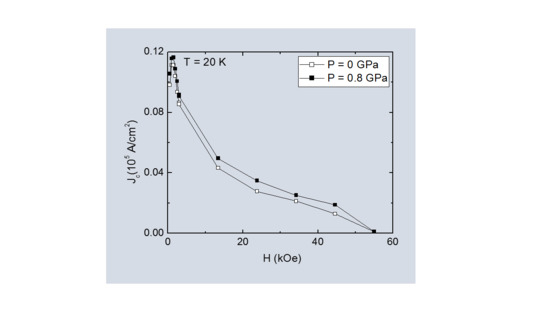Effect of Pressure on the Superconducting Properties of Tl2Ba2Ca2Cu3O9-δ
Abstract
:1. Introduction
2. Materials and Methods
3. Results and Discussions
4. Summary
Author Contributions
Funding
Acknowledgments
Conflicts of Interest
References
- Sefat, A.S. Pressure effects on two superconducting Iron-based families. Rep. Prog. Phys. 2011, 74, 124502. [Google Scholar] [CrossRef]
- Galez, P.; Hopfinger, T.; Soubeyroux, J.L.; Lomello-Tafin, M.; Opagiste, C. The reaction pathway for the formation of Tl-2223. Phys. C Supercond. 2002, 372–376, 1137–1140. [Google Scholar] [CrossRef]
- Maignan, A.; Martin, C.; Hardy, V.; Simon, C.; Hervieu, N.; Raveau, B. A crystal study of the 128 K superconductor Tl2Ba2Ca2Cu3O10−δ synthesis and anisotropic magnetic properties. Phys. C Supercond. 1994, 219, 407–412. [Google Scholar] [CrossRef]
- Lin, J.G.; Matsuishi, K.; Wang, Y.Q.; Xue, Y.Y.; Hor, P.H.; Chu, C.W. Pressure effects on the superconducting transition temperature of Tl2Can−1Ba2CunO2n+4−δ. Phys. C Supercond. 1991, 175, 627–633. [Google Scholar] [CrossRef]
- Tristan, D.; Wijngaarden, R.J.; Liu, R.S.; Tallon, J.L.; Griessen, R. Superconductivity at 133 K in Tl2Ba2Ca2Cu3O10+x under high pressure. Phys. C Supercond. 1993, 218, 24–28. [Google Scholar]
- Jover, D.T.; Wijngaarden, R.J.; Griessen, R.; Haines, E.M.; Tallon, J.L.; Liu, R.S. Pressure dependence of the superconducting critical temperature of Tl2Ba2Ca2Cu3O10+y and Tl2Ba2Ca3Cu4O12+y up to 21 GPa. Phys. Rev. B 1996, 54, 10175–10185. [Google Scholar] [CrossRef]
- Jover, D.T.; Wijngaarden, R.J.; Wilhelm, H.; Griessen, R.; Loureiro, S.M.; Capponi, J.-J.; Schilling, A.; Ott, H.R. Pressure dependence of the superconducting critical temperature of Hg2Ba2Ca2Cu3O8+y and HgBa2Ca3Cu4O10+y up to 30 GPa. Phys. Rev. B 1996, 54, 4265. [Google Scholar] [CrossRef]
- Shipra, R.; Sefat, A.S. Effect of Li2O on the microstructure, magnetic and transport properties of Tl-2223 superconductor. Phys. C Supercond. 2015, 519, 108–111. [Google Scholar] [CrossRef]
- Bean, C.P. Magnetization of hard superconductors. Phys. Rev. Lett. 1962, 8, 250. [Google Scholar] [CrossRef]
- Bean, C.P. Magnetization of high-field superconductors. Rev. Mod. Phys. 1964, 36, 31. [Google Scholar] [CrossRef]




© 2018 by the authors. Licensee MDPI, Basel, Switzerland. This article is an open access article distributed under the terms and conditions of the Creative Commons Attribution (CC BY) license (http://creativecommons.org/licenses/by/4.0/).
Share and Cite
Ijaduola, A.O.; Shipra, R.; Sefat, A.S. Effect of Pressure on the Superconducting Properties of Tl2Ba2Ca2Cu3O9-δ. Crystals 2019, 9, 4. https://doi.org/10.3390/cryst9010004
Ijaduola AO, Shipra R, Sefat AS. Effect of Pressure on the Superconducting Properties of Tl2Ba2Ca2Cu3O9-δ. Crystals. 2019; 9(1):4. https://doi.org/10.3390/cryst9010004
Chicago/Turabian StyleIjaduola, Anota O., Rai Shipra, and Athena S. Sefat. 2019. "Effect of Pressure on the Superconducting Properties of Tl2Ba2Ca2Cu3O9-δ" Crystals 9, no. 1: 4. https://doi.org/10.3390/cryst9010004




